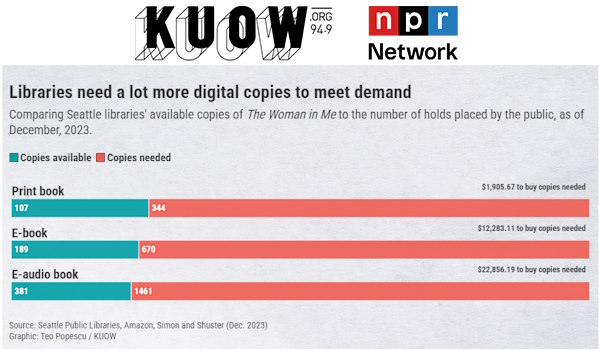This is my bi-weekly “newsletter” delivered straight to your inbox, as requested at some point in the past. Hopefully you’re enjoying it? If not, there’s a link down below to unsubscribe. No hard feelings! If you are, though, drop a comment on the blog, on the socials, or send me an email. (Unfortunately, replies to the newsletter email itself won’t be received.)
_ONE
Digital reading soars in Seattle, creating problems for local libraries | Clare McGrane & Patricia Murphy
By reducing the number of holds each patron can place, the library is essentially asking readers to be more choosy about which books to get in line for. Gutierrez said it’s already having an impact on their budget. “We have reduced the costs for holds by a significant amount,” she said. That means the library can put that money toward other titles. “We want depth and breadth to the collection. We want to be able to offer a variety of titles and not just feed the best sellers,” Gutierrez said. “So, this allows us to have funds redistributed also to acquire new content rather than have hundreds of copies of fewer titles.”
I’ve written about the library ebook problem many times before (including recently for the day job and here), and I’m glad to see it’s starting to get more mainstream coverage, not only in Seattle, but also in Iowa, and on the conference circuit.
A collection dominated by bestsellers is one that prioritizes a small percentage of the newest releases for a small percentage of a library’s potential readers. Even worse, thanks to restrictive licenses, bestsellers can end up dominating an inordinate percentage of a library’s budget, while under-serving readers with other interests. While single-user licenses are the most common way for libraries to add ebooks to their digital collections, it’s not the only licensing model available.
Libraries have more influence and power than they realize, and when they decide to use it to build more diverse digital collections, they’ll either find they have more leverage to negotiate better terms for bestsellers, or better yet, discover their influence can actually reshape which titles hit the bestseller lists that drive patron demand.
__TWO
What I Would Do If I Were Starting Book Riot Today | Jeff O’Neal
I don’t think I would start Book Riot today. It’s not about what we do, not at all. I think in many ways we are just beginning to figure out what we can be. But the road we took here is washed out and what remains is too unstable to build anything lasting on, not without the kind of money and time no one is giving media companies these days.
First, a disclaimer. I’ve been a fan of Book Riot for ages. Over the years, I’ve appeared on a couple of their podcasts, written for them, and collaborated with them while I was running the Panorama Project. Kelly Jensen’s ongoing coverage of book bans might be the most important contribution they’ve made to an industry that doesn’t deserve them.
O’Neal’s candid assessment of Book Riot’s past and present is a bracing read for anyone who’s followed the ups and downs of digital media and/or mainstream book coverage over the past 10-15 years, and I wholeheartedly agree that there’s no way Book Riot would make sense to launch today. The problem isn’t social media or ill-conceived pivots to the newest shiny. It’s neither Amazon, Facebook, nor Google.
It’s publishers.
Publishers off all sizes have bemoaned the decline in “traditional” media coverage of books while simultaneously shifting ad dollars away from the outlets that religiously produced that coverage. They chased every digital channel and “influencer” that appeared, spending less and less as they published more and more and marketed less and less, until the rented rug was pulled from under them, or “influence” proved to be difficult to measure, at best.
Sites like Book Riot are primarily supported by advertising, and many of those sites have found themselves chasing sketchy adtech to survive, reimagining themselves to support “better” advertising products, only to end up turning most of that inventory over to shitty programmatic ads. (Years ago, I had a blocklist of brands who were trying to backdoor us through Google Ads rather than advertise direct because it was cheaper and I couldn’t convince my bosses to kill programmatic ads outright.)
Sadly, I recently unsubscribed from Book Riot’s comics newsletter, not because the content wasn’t good, but because it’s become unreadable thanks to programmatic ads taking up prominent spaces designed to put a spotlight on publishers’ marketing efforts. Publishers who, for whatever reason, aren’t advertising with them. If publishers don’t see the value of regularly supporting sites like Book Riot — unless they’ve built up their own reader-facing platforms (very few have) — they have no one but themselves to blame when TikTok eventually follows the path of every other intermediary they’ve relied on over the years. When all of their digital advertising ends up on AI-generated content mills whose only visitors are bots designed to deliver pageviews for fraudulent programmatic networks, they’ll think back fondly on the Book Riots and wonder why there aren’t any good websites covering their books anymore.
___THREE
As TikTok ban threatens stability in social media ecosystem, some brands settle into the fediverse | Kimeko McCoy
TikTok’s golden goose is its algorithm, which China likely won’t sell off as part of any deal and thus, calling into question what exactly a buyer would get in purchasing the platform. In the meantime, it shrouds the social media stratosphere in another layer of uncertainty as marketers are faced with the threat of losing a segment of their digital audiences. It begs the question: In today’s social landscape, do brands ever own their audiences?
Did you feel that ripple roll through the offices of corporate publishers yesterday? Their email servers were burning up with links to stories about the TikTok “ban,” and marketing executives are now scrambling to figure out if some other AI tool can be the next silver bullet to do their jobs for them. (I’m surprised TikTok’s beloved algorithm doesn’t come up as one of the “AI” tools publishers already rely on.)
I don’t think the Fediverse is the answer to most publishers’ marketing challenges because they’ll always just follow the crowd wherever it goes (or where their preferred intermediaries tell them it went), and conventional wisdom says the “bookish” crowd is all on TikTok. I wouldn’t be surprised if publishers collectively forget their tortured histories with Facebook (Meta), and declare Threads as the next new shiny before the end of the year.
____FOUR
Updating California’s grid for EVs may cost up to $20 billion | John Timmer
By 2025, only about 7 percent of the feeders will experience periods of overload. By 2030, that figure will grow to 27 percent, and by 2035—only about a decade away—about half of the feeders will be overloaded. Problems grow a bit more slowly after that, with two-thirds of the feeders overloaded by 2045, a decade after all cars sold in California will be EVs. At that point, total electrical demand will be close to twice the existing capacity.
I’m glad we’re starting to see more coverage about the ripple effects of the push to electrifying automobiles. It’s one thing to set lofty goals for the switch to EVs, but much like “No Child Left Behind” and other ambitious initiatives, the funding has to be there to fully support it or else it’s just political theater.
Between Tesla’s slow-motion implosion, a slower-than-expected trajectory for EV adoption (in the US), and the various obstacles to supporting even a modest shift to electrification in wide swaths of the country, I’m starting to believe we’re going to see the EV bubble deflate (or even burst) in the next three years, and the blame will absolutely be put on consumers. (Or, maybe Toyota is proven right and hybrids are taken more seriously in short-term?)
I’m also waiting for someone smarter than me to connect the dots between the relentless push for energy-hungry AI tools, the challenges facing EVs, and who benefits from which scenarios winning out…
_____FIVE
Generational Shift | Sean Kleefeld
Which means that Gen X had ongoing access to not only art that reflected their life, but art that reflected the lives of everyone over the previous 50-75 years. Granted, Leave It to Beaver was never a perfect reflection of anybody’s actual life, but it was a window into what that era was like. It reflected the values of that time. Gen X saw, through the proliferation of channels and long Saturday afternoons, glimpses into what it was like in previous eras. Something that previous generations simply did not have access to.
I don’t usually like generational stereotypes, but I’m a sucker for an interesting Gen X analysis, and I enjoyed Kleefeld’s take on the differences in our access to media and the generations before and after.
I remember being annoyed at times how much attention the 1950s got when I was growing up, but I also loved watching the original Little Rascals every day after school. The Honeymooners was as much a favorite as The A-Team and Taxi, but part of that was because we didn’t have a lot of options to choose from.
In NYC, we had six seven channels: CBS (2), NBC (4), ABC (7), PBS (13), and whatever 5, 9, and 11 were back then. Local sports were accessible to everyone with an antenna, while cable was for rich kids, and theaters were the only way you saw movies without commercials. Ironically, this generation appears to be on the verge of rediscovering commercial breaks, but with the modern bonus of having to pay for them!
I believe media definitely has an influence on culture, and vice versa, so the idea that Gen X might have a broader cultural understanding than previous generations is compelling. At the same time, there’s SO MUCH CONTENT available today, combined with far more diversity at every level than we’d ever dreamed of, that I think the current generation has a much bigger advantage — but they have to choose well.
If you’re reading this somewhere other than your inbox and would like to get it via email, sign up here, or you can add the RSS feed to your favorite reader. You do you!
Do you like email?
Sign up here to get my bi-weekly "newsletter" and/or receive every new blog post delivered right to your inbox. (Burner emails are fine. I get it!)



“When all of their digital advertising ends up on AI-generated content mills whose only visitors are bots designed to deliver pageviews for fraudulent programmatic networks, they’ll think back fondly on the Book Riots and wonder why there aren’t any good websites covering their books anymore.”
Why aren’t more suckers doing all their publishing and marketing work for free? (and if their response is, “but we give them free ebooks!”, my screams of rage will shake their brains in their skulls)
“I wouldn’t be surprised if publishers collectively forget their tortured histories with Facebook (Meta), and declare Threads as the next new shiny before the end of the year.”
::twitching:: (considering how political analysts and media in general “forget” what has happened/was happening/is happening and their own culpability, literally every week, let alone every election cycle…yeah)
(I also just noticed the “keep blogs alive!” thing above the comments box, and boy, do I feel that!)
I assume most good book bloggers still plugging away are doing it for the love of the community rather than free ebooks or potential advertising, or at least that’s what I’d like to believe! I stopped reviewing comics years ago partly because the grind wore me down, and partly because I realized what a shitty industry it could be.
That’s why I keep at it myself; a “free ebook” will never make up for the hours involved in reading, processing, then writing a decent critical review of a book–who when DNFing, I do my damnedest to at least explain what made me stop reading–because one reader’s horror is another reader’s jam.
But publishers seem to prefer five stars and many enthusiastic emojis to reviews that ensure those readers can choose to read authors they’ll enjoy–which will ensure that author finds their audience, and therefore has a chance at an actual writing career.
Instead, if readers have no elements to make reading decisions, and are burned off a reader, and that author’s next book is greeted with, “all that hype was bullshit” and the sales tank, oh well, there are other authors waiting to be churned through, so the publishers don’t care.
(I know you know this much better than I do, but there are so many good writers who barely got a chance, whose careers were killed by publishing….gah)
Early in my career, I really thought I wanted to work in book publishing, but the more I learned about how the industry operates, the more I was happy to stay on the periphery. Libraries can be frustrating, but they don’t consistently work against their own best interests the way traditional publishing does. TBH, I’d go back to the magazine world in a minute… if it still existed in any meaningful way. 🙁
gah, yes; the loss of magazines as a thriving sector of publishing is incredibly sad (and incredibly enraging)
I agree that as much as I love Book Riot’s content, the ads are so obnoxious that I hate going to their site and their newsletters are a garbled mess. I hope they can figure out a way through it.
Ironically, I got the latest newsletter at my work email (forgot I was subscribed at both) and four of the ad units were taken by Penguin Teen. It looks better, but it’s still overkill, and there’s a bonus programmatic ad in the last slot because of course there is. Sigh…
” I wouldn’t be surprised if publishers collectively forget their tortured histories with Facebook (Meta), and declare Threads as the next new shiny before the end of the year.”
….yeah, probably.
Re: EVs – The key to preventing energy shortages is decentralized energy production. Solar, wind (backyard), even small local nuclear. As shortages get more apparent, I hope the demand for local production will push people to speed up their own energy production. “The Grid” was never sustainable and was always on the brink of failing.
I fear asking and don’t want to Google it, but wtf is “small local nuclear”?!?
It’s a portable reactor that can be used to power Small towns or buildings. Works like the ones on ships and submarines. “Small modular reactors (SMRs) are a class of small nuclear fission reactors that can be built in a factory and shipped to operational sites for installation. SMRs can have a maximum output of 300 Megawatt electric (MWe) and produce 7,200,000 kWh per day. In comparison, large-size nuclear power plants have an output of over 1,000 MWe and can produce 24,000,000 kWh per day.”
Interesting. Did some quick reading, seems like they’re behind hydrogen in terms of development and cost to scale, and I’d assume they’d carry nuclear’s usual stigma for anything beyond federal use.